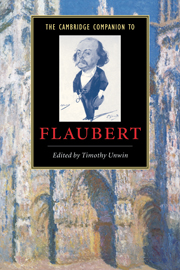Book contents
- Frontmatter
- 1 Gustave Flaubert, the hermit of Croisset
- 2 Flaubert’s place in literary history
- 3 Flaubert’s early work
- 4 Flaubert’s travel writings
- 5 Flaubert’s correspondence
- 6 History and its representation in Flaubert’s work
- 7 Death and the post mortem in Flaubert’s works
- 8 The art of characterisation in Flaubert’s fiction
- 9 The stylistic achievements of Flaubert’s fiction
- 10 The writing process
- 11 Flaubert and the visual
- 12 The theatre in the work of Flaubert
- 13 Flaubert’s failure
- 14 Flaubert, our contemporary
- Select bibliography
- Index
- Series List
11 - Flaubert and the visual
Published online by Cambridge University Press: 28 May 2006
- Frontmatter
- 1 Gustave Flaubert, the hermit of Croisset
- 2 Flaubert’s place in literary history
- 3 Flaubert’s early work
- 4 Flaubert’s travel writings
- 5 Flaubert’s correspondence
- 6 History and its representation in Flaubert’s work
- 7 Death and the post mortem in Flaubert’s works
- 8 The art of characterisation in Flaubert’s fiction
- 9 The stylistic achievements of Flaubert’s fiction
- 10 The writing process
- 11 Flaubert and the visual
- 12 The theatre in the work of Flaubert
- 13 Flaubert’s failure
- 14 Flaubert, our contemporary
- Select bibliography
- Index
- Series List
Summary
The sheer density of visual information and the pressure placed on the reader to be an observer, to behold the real, make Flaubert's work a model for pictorial representation in fiction. Flaubert is not unique in the history of the nineteenth-century novel for his valuation of the visual. But in his work the visual asserts itself as the single most reliable carrier of signification. The work rests on the power of the visual to sway us or to convince us of the accuracy, realism and truth-telling merit of its representations. Whether or not it ultimately delivers on the meaning it promises, the visual in Flaubert offers nonetheless an open invitation to interpretation and discussion. The centrality of the visual is as true in the realistic novels like Madame Bovary and L'Education sentimentale as it is in the romantic works like La Tentation de saint Antoine and Salammbô. Both styles are marked by a high degree of visuality and both exemplify the dominance of the visual in nineteenth-century literature and culture.
- Type
- Chapter
- Information
- The Cambridge Companion to Flaubert , pp. 180 - 195Publisher: Cambridge University PressPrint publication year: 2004
- 1
- Cited by



